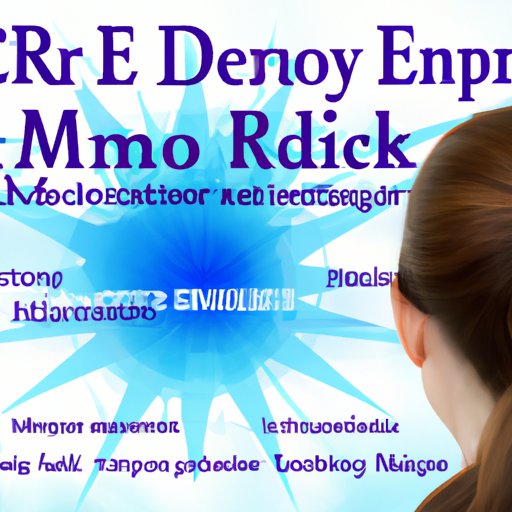Introduction
Eye Movement Desensitization and Reprocessing (EMDR) therapy is an innovative form of psychotherapy that has been used since the late 1980s to treat a range of psychological issues. It is often used to treat post-traumatic stress disorder (PTSD), anxiety, depression, phobias, panic attacks, and other mental health issues. In this article, we will explore what EMDR therapy is, its benefits, techniques, effects, and mechanisms.
Exploring the Basics of EMDR Therapy
EMDR therapy is a type of psychotherapy that uses eye movements, sound, or tactile stimulation to help people process traumatic memories and experiences. During EMDR sessions, the therapist will ask the patient to recall a traumatic event while focusing on a specific stimulus, such as a moving light or sound. The goal of EMDR is to help the patient process and integrate their experience in a more positive way.
How Does it Work?
The basic idea behind EMDR is that the brain can become “stuck” when confronted with a traumatic experience. EMDR helps the person move through the experience by stimulating the brain in different ways. This stimulation helps the person reprocess the experience in a new way, allowing them to make sense of it and come to terms with what happened.
What are the Benefits?
EMDR has been shown to be effective in treating a variety of mental health issues, including PTSD, anxiety, depression, phobias, and panic attacks. Studies have found that EMDR is more effective than cognitive behavioral therapy (CBT) for treating PTSD, and it can also reduce symptoms of anxiety, depression, and phobias. EMDR has also been found to be effective in reducing symptoms of post-traumatic stress in survivors of natural disasters and terrorist attacks.
What Techniques are Used?
During an EMDR session, the therapist will use a variety of techniques to help the patient process their experience. These techniques may include eye movements, hand tapping, sounds, or other forms of tactile stimulation. The therapist will also use talk therapy to help the patient process their experience and gain insight into their feelings and reactions.

A Comprehensive Guide to EMDR Therapy
In order to understand how EMDR works, it is important to understand its effects and mechanisms. EMDR works by stimulating the brain in a way that helps the person reprocess their experience in a new way. This is done by using various techniques such as eye movements, sounds, or tactile stimulation. By stimulating the brain in this way, the person is able to process their experience in a more effective way and gain insight into their feelings and reactions.

What it Can Do for Mental Health Issues
EMDR has been found to be effective in treating a variety of mental health issues, including PTSD, anxiety, depression, phobias, and panic attacks. Studies have found that EMDR is more effective than cognitive behavioral therapy (CBT) for treating PTSD, and it can also reduce symptoms of anxiety, depression, and phobias. EMDR has also been found to be effective in reducing symptoms of post-traumatic stress in survivors of natural disasters and terrorist attacks.

Examining the Science Behind EMDR Therapy
In order to understand how EMDR works, it is important to look at the science behind it. According to research, EMDR works by stimulating the brain in a way that helps the person reprocess their experience in a new way. This is done by using various techniques such as eye movements, sounds, or tactile stimulation. By stimulating the brain in this way, the person is able to process their experience in a more effective way and gain insight into their feelings and reactions.
Research has also shown that EMDR increases the activity of certain neurotransmitters, such as serotonin and dopamine, which can help regulate mood and reduce stress. This suggests that EMDR may be effective in treating mental health issues by helping to regulate the brain’s chemistry.
Why it Helps
Research has shown that EMDR increases the activity of certain neurotransmitters, such as serotonin and dopamine, which can help regulate mood and reduce stress. This suggests that EMDR may be effective in treating mental health issues by helping to regulate the brain’s chemistry. Additionally, EMDR helps people to process their traumatic experiences in a more effective way, allowing them to gain insight into their feelings and reactions.
Conclusion
EMDR therapy is an innovative form of psychotherapy that has been used since the late 1980s to treat a range of psychological issues. It is often used to treat post-traumatic stress disorder (PTSD), anxiety, depression, phobias, panic attacks, and other mental health issues. This article explored the basics of EMDR therapy, its benefits, techniques, effects, and mechanisms. We also looked at the science behind EMDR therapy and how it works. EMDR has been found to be effective in treating a variety of mental health issues, including PTSD, anxiety, depression, phobias, and panic attacks. It can also help regulate the brain’s chemistry and help people process their traumatic experiences in a more effective way.
(Note: Is this article not meeting your expectations? Do you have knowledge or insights to share? Unlock new opportunities and expand your reach by joining our authors team. Click Registration to join us and share your expertise with our readers.)
